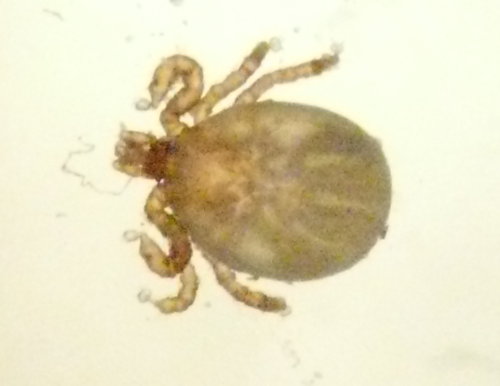Difference between revisions of "Clinical Case 7 - Page 3"
Jump to navigation
Jump to search
(New page: <big><center>'''BACK'''</center></big> Courtesy of C. Antonczyk thumb|center|500px|(Courtesy of C. Antonczyk)) |
|||
| (4 intermediate revisions by one other user not shown) | |||
| Line 4: | Line 4: | ||
[[Image:Clinical Case 7 03.jpg|thumb|center|500px|(Courtesy of C. Antonczyk)]] | [[Image:Clinical Case 7 03.jpg|thumb|center|500px|(Courtesy of C. Antonczyk)]] | ||
| + | |||
| + | |||
| + | |||
| + | |||
| + | In order to reveal an answer, highlight the underlined or bulleted area using your mouse. | ||
| + | The number of bullet points doesn't necessarily indicate a strict number of answers. | ||
| + | |||
| + | |||
| + | What is this? | ||
| + | *<font color="white"> This is a tick. It has 3 pairs of legs which makes it a larval tick. Nymphs and adults have four pairs of legs. </font> | ||
| + | |||
| + | How would you treat this condition? | ||
| + | *<font color="white"> Fin was treated with a spot on application of fipronil and as many of the parasites as possible were removed manually. Care must be taken not to break off the mouth parts when reomoving ticks as they can cause an irritating local reaction. </font> | ||
| + | |||
| + | |||
| + | <big><center>[[Cases from General Practice - Small Animal|'''BACK TO CASES FROM GENERAL PRACTICE - SMALL ANIMAL''']]</center></big> | ||
| + | |||
| + | |||
| + | [[Category:Lost]] | ||
Latest revision as of 17:00, 24 February 2011
Courtesy of C. Antonczyk
In order to reveal an answer, highlight the underlined or bulleted area using your mouse. The number of bullet points doesn't necessarily indicate a strict number of answers.
What is this?
- This is a tick. It has 3 pairs of legs which makes it a larval tick. Nymphs and adults have four pairs of legs.
How would you treat this condition?
- Fin was treated with a spot on application of fipronil and as many of the parasites as possible were removed manually. Care must be taken not to break off the mouth parts when reomoving ticks as they can cause an irritating local reaction.
